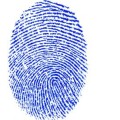Biometrics
Biometrics is the science and technology of authentication (i.e.) establishing the identity of an individual by measuring the person's physiological or behavioral features. The term is derived from the Greek words "bios," for life and "metron," for degree. In information technology (IT), biometrics, usually refers to technologies for measuring and analyzing human physiological characteristics such as fingerprints, eye retinas and irises, voice patterns, facial patterns, and hand measurements, especially for authentication purposes. Examples of behavioural characteristics which can be measured include signature recognition, gait recognition, speaker recognition and typing recognition.
The first effective biometrics system was the anthropometric system designed by Alphonse Bertillion in 1883, the first precise scientific system widely used to identify criminals. It worked by precisely measuring certain lengths and widths of the head and body. Due to problems with differing methods of measurement and changing measurements, however, it was supplanted by fingerprinting.
In a typical IT biometric system, a person registers with the system when one or more if his physiological characteristics are obtained, processed by a numerical algorithm, and entered into a database. Ideally, when he logs in, all of his features match 100%; then when someone else tries to log in, she does not fully match, so the system will not allow her to log in. However, current technologies are nowhere close to matching this ideal.
Performance of a biometric measure is usually referred to in terms of the false accept rate (FAR), the false nonmatch or reject rate (FRR), and the failure to enroll rate (FTE or FER).
In real-world biometric systems, the FAR and FRR can typically be traded off against each other by changing some parameter. One of the most common measures of real-world biometric systems is the rate at the setting at which both accept and reject errors are equal: the equal error rate (EER), also known as the cross-over error rate (CER). The lower the ERR or CER, the more accurate the system is considered to be.
Claimed error rates sometimes involve idiosyncratic or subjective elements. For example, one biometrics vendor set the acceptance threshold high, to minimize false accepts; in the trial, three attempts were allowed, and so a false reject was counted only if all three attempts failed. Another example: when measuring performance biometrics (e.g.) writing, speech etc., opinions may differ on what constitutes a false reject. If I train a signature verification system using my initial and surname, can I legitimately claim a false reject when it then rejects my first name and surname?
Despite these misgivings, biometric systems have the potential to identify individuals with a very high degree of certainty. Forensic DNA evidence enjoys a particularly high degree of public trust at present (circa. 2004) and substantial claims are being made in respect of iris recognition technology, which has the capacity to discriminate between individuals with identical DNA.
As with many interesting and powerful developments of technology, excessive concern with the biometric may have the effect of eclipsing a more general critical faculty. Biometrics may become associated with several miscarriages of justice if bedazzlement with the performance of the technology blinds us to the following possibilities, where an individual could:
* Plant DNA at the scene of the crime * Associates another's identity with his biometrics, thereby impersonating without arousing suspicion * Fools a fingerprint detector by using a piece of sticky tape with an authentic fingerprint on it * Fools an iris recognition camera by showing a photo of another's iris * Interferes with the interface between a biometric device and the host system, so that a "fail" message gets converted to a "pass." And here we can see, both the perfectly hopeful potential of biometrics; as well as the potentially imperfect misuses of this scientific innovation.

